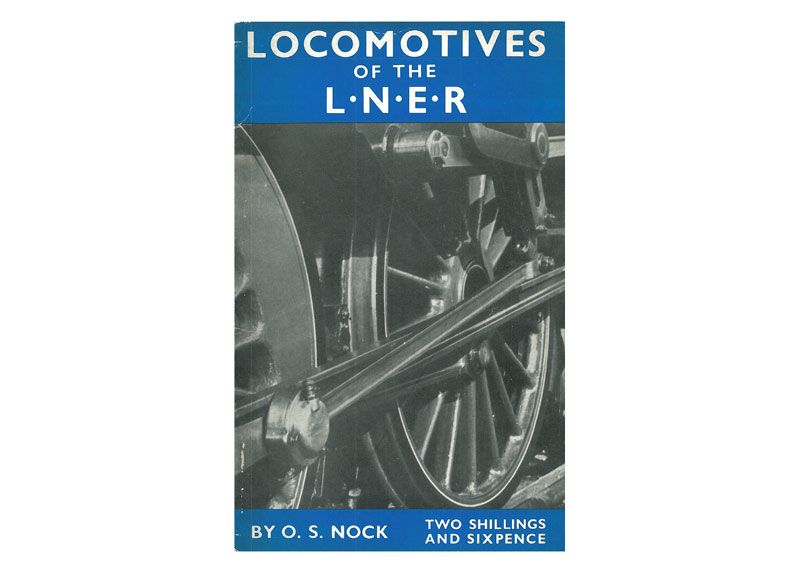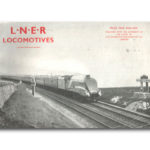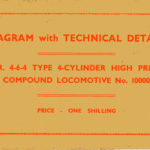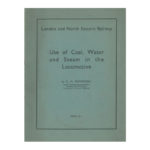Description
When Sir Nigel Gresley died aged 65 on 5thApril 1941, the official LNER retiring age for Chief Officers was 65, but the Board had assumed that as a widower, with both sons serving in the army, and with his office moved from Kings Cross as part of air raid precautions, he would have been prepared to serve for the duration. HNG’s small staff was relocated to his home at Watton-at Stone, Hertfordshire (it was known as HQ2, HQ1 being the main location for other all-line Chief Officers, a large country house called “The Hoo”. Until Oliver Bulleid left to become CME of the Southern Railway he might have been regarded as the “Heir Apparent”, but no one else had occupied his unique position as HNG’s right hand man. Outside of the LNER, Gilbert Szlumper General Manager of the Southern, on loan to the Govt. and a member of the wartime Railway Executive Committee, noted in his diary, when a couple of weeks had passed and no replacement announced, that the best solution might be to have Stanier as CME of both the LMS and the LNER. However, Stanier was approaching normal retirement age and it would be a tough job, for an elderly man, however brilliant, to take on both. Also it was then not well known that Stanier would be leaving the railway industry to become a Government Scientific Adviser
The LNER senior Area Mechanical Engineer, EdwardThompson was neurotic, narcissistic, with evidence of a persecution complex, and signs of increasing hypochondria. Some Directors and Senior Officers referred to him as “Deadward Thompson” and these personality traits became more pronounced following the sudden death of his wife Gwen, (a daughter of Sir Vincent Raven) when they were preparing to move house to Doncaster on Thompson’s appointment as Area Mechanical Engineer there in 1938. When he died he was found to have 40 suits, around 100 shirts and dozens of pairs of shoes. Once, finding the temperature of his office not within the limits set by his written instructions, he flew into a rage, snatched a thermometer from the wall and threw it through a double glazed window. Gresley told one of his daughters that Thompson was “disloyal.” Thompson, in interviews after his own retirement claimed that HNG had held him back and that Sir Vincent Raven his own father in law “scarcely knew the difference between an engine and a tender”.
In view of Thompson’s worsening personality defects and a tendency to treat staff and members of the workforce with an indifference bordering on contempt, Company Chairman Sir Ronald Matthews tried very hard to find someone else to succeed Gresley instead of Thompson. This must have been a difficult decision for Sir Ronald to take (in the best interests of the LNER) because he and Lady Matthews were amongst the few friends Thompson (a brother Freemason) had, and he was a frequent weekend guest at their home, following his bereavement. It would obviously not be fitting to be seen touting for a replacement CME, at least until after HNG’s funeral, which was held at Netherseale, Staffordshire on Wednesday 9th April. Given the restrictions and difficulties of war- time travel a Memorial Service was held on the same day at Chelsea Old Church.
Seeking a suitable candidate was a delicate matter. In the days when telephone calls passed through several switchboards, each with an operator who could listen in, it would entail personal meetings. This would be no easy task, with bombing raids on London by the Germans every night and consequent damage to railways and roads. Sir Ronald would first need to meet with Andrew K. McCosh, the LNER Director who chaired the Locomotive Committee, to share his misgivings over Thompson, and agree that if possible, an alternative candidate should be found. It had been envisaged that Gresley might go at age 70, Thompson around the same time at age 65, with Arthur Peppercorn then taking the CME’s job. He in turn would be succeed by Freddie Harrison. For Peppercorn to by- pass Thompson in 1941, it was unlikely that the full Board would agree. It would have to be someone from off the LNER. The ideal candidate would have been Oliver Bulleid, but etiquette of poaching an officer from another railway prohibited a direct approach, so Sir Ronald would need to meet Robert Holland-Martin, Southern Railway Chairman, as a first step. Holland-Martin was a good- humoured kindly man, but with the Southern policy that all Board decisions must be unanimous, or be held over for discussion at the next meeting, he could not envisage an agreement being reached to release Bulleid from his contract. It is possible that he allowed Sir Ronald to approach Bulleid direct. But as his prototype “Merchant Navy” class Pacific “Channel Packet” had been named a couple of weeks earlier, much work curing teething problems was require before building the first and Thompson tempted away.
This left the possibility of getting someone from the LMS. If conditions were normal, George Ivatt (son of GNR Loco Engineer H.A. Ivatt) would have been a good choice, but he was fully committed to designing and building Cruiser Tanks at Derby Loco works. There remained one possibility – Roland Bond, who had enjoyed the unique position of being an officer of both the LNER and the LMS with half his salary paid by each, as Superintendent Engineer of the Rugby Locomotive Testing Station. Work on building the station was suspended early in the war, leaving Bond, a highly qualified locomotive engineer free. The LMS appointed him Acting Mechanical Engineer, Scotland, based at St. Rollox, Glasgow, thus releasing Robert Riddles to be loaned to the Ministry of Supply.
Sir Ronald and Andrew McCosh both knew and liked Bond through meetings planning the Test Centre. He had been, at least 50% an LNER officer, his Scottish appointment was “acting”, presumably keeping the chair warm for a return by Riddles. Could he in the National interest, be released to the LNER? Power in the LMS was concentrated largely in the hands of one man, the economist Lord Stamp, who was not only Chairman of the Board of Directors, but also, in an arrangement taken from USA business methods, “President of the Executive”- a body of vice presidents which was supposed to fulfil the role of General Manager. Stamp was a busy and ambitious man, who by no means devoted himself full time to the LMS. He was on various boards and committees with a view to furthering his wish to succeed Montagu Norman as Governor of the Bank of England. Over a week had now passed since HNG’S death, Bulleid was ruled out. A meeting with Stamp was essential, but before it could be arranged, on the night of 16th April, he was killed by a direct hit from a German bomb on his house at Shortlands, This second blow to the Railway Industry threw the management of the LMS into more than its usual disarray. It is not known if Sir Ronald tried to raise the question of Bond with Senior Vice president Sir William Wood, but it would have been too late. Bond had already been handed a highly confidential handwritten letter from Stanier to the effect that the Manager of Crewe Works was no longer capable and was going to be retired. Bond was ordered to replace him from the first week in May.
Sir Ronald was left with no choice and after nearly three weeks delay, Thompson was appointed with effect from 24th April. One can only guess what effect this delay had on his difficult personality. However, the appointment, was at a reduced salary, electrical engineering was removed from his oversight. He was also told that in his case there would be no retirement deferral beyond age 65. Sir Ronald also moved the genial and popular Arthur Peppercorn from Darlngton to take up Thompson’s old post at Doncaster, and to be designated Deputy CME. This can be seen as a damage limitation exercise. Soon after his appointment, Thompson called a meeting of works managers and other senior staff directly responsible to him. As immaculately dressed as ever, he presided in his usual aloof and urbane manner, doing most of the talking. His closing remarks on that occasion were very significant: “I have a lot to do, gentlemen, and little time in which to do it.” This made it quite clear that war or no war it was not going to be “business as usual”, but he would follow his own agenda.
One cannot but feel sorry for “Pepps”. With Thompson’s dictatorial attitude, refusing to listen to dissent, or even alternative suggestions, he and to a lesser extent, Freddie Harrison at Gorton, found themselves rather in the role of those circus employees who had to follow the elephants with buckets and shovels. Meetings which had left participants angry and confused had to be held again when Thompson was out of the way. Peppercorn suffered even worse, because Thompson also lived in Doncaster. “Pepps” lost his first wife in1935. There were no children. After a hard day at work, he liked to enjoy a quiet dinner at home, then settle down in his favourite armchair with a good book, All too often, late in the evening, Thompson would telephone and ask him to come round to discuss something which could not wait until the morrow. There is I think little doubt that the pressures of working under Thompson contributed to Peppercorn’s death at the comparatively early age of 62.
Thompson’s two notable achievements were first the complete renumbering of the LNER loco stock in a logical format, a complex business, long overdue which involved some engines being renumbered twice. Second, the B1 class mixed traffic 4-6-0, which contemporary opinion held to be at least as good as the LMS “Black 5s” and were actually cheaper to build.
Off his “Pacifics” the least said the better. Amongst the ugliest main line passenger locomotives to run in Britain, they gave the impression that they were trying to leap over their own bogies.
It is difficult to know quite what the purpose of this booklet was. On page 19 it mentions that Thompson’s period in office would go down “as a momentous one” and that he had retired before this monograph was completed. He retired in June 1946 and much of the loco building and rebuilding in his plans would never take place. The. booklet was not published until 1947, yet there is no mention of Arthur Peppercorn, as Thompson’s successor. And why, when the LNER had two excellent writers on the staff, C. J. Allen and George Dow, was an outsider paid to write it? Could it be that these insiders knew too much to be at all eulogistic?





Reviews
There are no reviews yet.